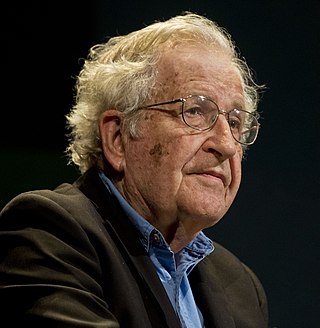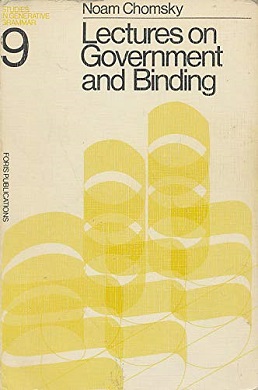
Universal grammar (UG), in modern linguistics, is the theory of the innate biological component of the language faculty, usually credited to Noam Chomsky. The basic postulate of UG is that there are innate constraints on what the grammar of a possible human language could be. When linguistic stimuli are received in the course of language acquisition, children then adopt specific syntactic rules that conform to UG. The advocates of this theory emphasize and partially rely on the poverty of the stimulus (POS) argument and the existence of some universal properties of natural human languages. However, the latter has not been firmly established, as some linguists have argued languages are so diverse that such universality is rare, and the theory of universal grammar remains controversial among linguists.
A noun phrase – or NP or nominal (phrase) – is a phrase that usually has a noun or pronoun as its head, and has the same grammatical functions as a noun. Noun phrases are very common cross-linguistically, and they may be the most frequently occurring phrase type.
In language, a clause is a constituent that comprises a semantic predicand and a semantic predicate. A typical clause consists of a subject and a syntactic predicate, the latter typically a verb phrase composed of a verb with any objects and other modifiers. However, the subject is sometimes unvoiced if it is retrievable from context, especially in null-subject language but also in other languages, including English instances of the imperative mood.
In linguistics, X-bar theory is a model of phrase-structure grammar and a theory of syntactic category formation that was first proposed by Noam Chomsky in 1970 reformulating the ideas of Zellig Harris (1951), and further developed by Ray Jackendoff, along the lines of the theory of generative grammar put forth in the 1950s by Chomsky. It attempts to capture the structure of phrasal categories with a single uniform structure called the X-bar schema, basing itself on the assumption that any phrase in natural language is an XP that is headed by a given syntactic category X. It played a significant role in resolving issues that phrase structure rules had, representative of which is the proliferation of grammatical rules, which is against the thesis of generative grammar.
In linguistics, the minimalist program is a major line of inquiry that has been developing inside generative grammar since the early 1990s, starting with a 1993 paper by Noam Chomsky.
In linguistic typology, a null-subject language is a language whose grammar permits an independent clause to lack an explicit subject; such a clause is then said to have a null subject.
A pro-drop language is a language in which certain classes of pronouns may be omitted when they can be pragmatically or grammatically inferable. The precise conditions vary from language to language, and can be quite intricate. The phenomenon of "pronoun-dropping" is part of the larger topic of zero or null anaphora. The connection between pro-drop languages and null anaphora relates to the fact that a dropped pronoun has referential properties, and so is crucially not a null dummy pronoun.
Principles and parameters is a framework within generative linguistics in which the syntax of a natural language is described in accordance with general principles and specific parameters that for particular languages are either turned on or off. For example, the position of heads in phrases is determined by a parameter. Whether a language is head-initial or head-final is regarded as a parameter which is either on or off for particular languages. Principles and parameters was largely formulated by the linguists Noam Chomsky and Howard Lasnik. Many linguists have worked within this framework, and for a period of time it was considered the dominant form of mainstream generative linguistics.
In generative grammar, non-configurational languages are languages characterized by a flat phrase structure, which allows syntactically discontinuous expressions, and a relatively free word order.
The term predicate is used in two ways in linguistics and its subfields. The first defines a predicate as everything in a standard declarative sentence except the subject, and the other defines it as only the main content verb or associated predicative expression of a clause. Thus, by the first definition, the predicate of the sentence Frank likes cake is likes cake, while by the second definition, it is only the content verb likes, and Frank and cake are the arguments of this predicate. The conflict between these two definitions can lead to confusion.
A pro-sentence is a sentence where the subject pronoun has been dropped and therefore the sentence has a null subject.
In linguistics, antisymmetry is a syntactic theory presented in Richard S. Kayne's 1994 monograph The Antisymmetry of Syntax. It asserts that grammatical hierarchies in natural language follow a universal order, namely specifier-head-complement branching order. The theory builds on the foundation of the X-bar theory. Kayne hypothesizes that all phrases whose surface order is not specifier-head-complement have undergone syntactic movements that disrupt this underlying order. Others have posited specifier-complement-head as the basic word order.
The subject-side parameter, also called the specifier–head parameter, is a proposed parameter within generative linguistics which states that the position of the subject may precede or follow the head. In the world's languages, Specifier-first order is more common than Specifier-final order. For example, in the World Atlas of Linguistic Structures (WALS), 76% of the languages in their sample Specifier-first. In this respect, the subject-side parameter contrasts with the head-directionality parameter. The latter, which classifies languages according to whether the head precedes or follows its complement, shows a roughly 50-50 split: in languages that have a fixed word order, about half have a Head-Complement order, and half have a Complement-Head order.
The generative approach to second language (L2) acquisition (SLA) is a cognitive based theory of SLA that applies theoretical insights developed from within generative linguistics to investigate how second languages and dialects are acquired and lost by individuals learning naturalistically or with formal instruction in foreign, second language and lingua franca settings. Central to generative linguistics is the concept of Universal Grammar (UG), a part of an innate, biologically endowed language faculty which refers to knowledge alleged to be common to all human languages. UG includes both invariant principles as well as parameters that allow for variation which place limitations on the form and operations of grammar. Subsequently, research within the Generative Second-Language Acquisition (GenSLA) tradition describes and explains SLA by probing the interplay between Universal Grammar, knowledge of one's native language and input from the target language. Research is conducted in syntax, phonology, morphology, phonetics, semantics, and has some relevant applications to pragmatics.

In linguistics, an empty category, which may also be referred to as a covert category, is an element in the study of syntax that does not have any phonological content and is therefore unpronounced. Empty categories exist in contrast to overt categories which are pronounced. When representing empty categories in tree structures, linguists use a null symbol (∅) to depict the idea that there is a mental category at the level being represented, even if the word(s) are being left out of overt speech. The phenomenon was named and outlined by Noam Chomsky in his 1981 LGB framework, and serves to address apparent violations of locality of selection — there are different types of empty categories that each appear to account for locality violations in different environments. Empty categories are present in most of the world's languages, although different languages allow for different categories to be empty.
Nina Hyams is a distinguished research professor emeritus in linguistics at the University of California in Los Angeles.
In linguistics and grammar, Avalency refers to the property of a predicate, often a verb, taking no arguments. Valency refers to how many and what kinds of arguments a predicate licenses—i.e. what arguments the predicate selects grammatically. Avalent verbs are verbs which have no valency, meaning that they have no logical arguments, such as subject or object. Languages known as pro-drop or null-subject languages do not require clauses to have an overt subject when the subject is easily inferred, meaning that a verb can appear alone. However, non-null-subject languages such as English require a pronounced subject in order for a sentence to be grammatical. This means that the avalency of a verb is not readily apparent, because, despite the fact that avalent verbs lack arguments, the verb nevertheless has a subject. According to some, avalent verbs may have an inserted subject, which is syntactically required, yet semantically meaningless, making no reference to anything that exists in the real world. An inserted subject is referred to as a pleonastic, or expletive it. Because it is semantically meaningless, pleonastic it is not considered a true argument, meaning that a verb with this it as the subject is truly avalent. However, others believe that it represents a quasi-argument, having no real-world referent, but retaining certain syntactic abilities. Still others consider it to be a true argument, meaning that it is referential, and not merely a syntactic placeholder. There is no general consensus on how it should be analyzed under such circumstances, but determining the status of it as a non-argument, a quasi-argument, or a true argument, will help linguists to understand what verbs, if any, are truly avalent. A common example of such verbs in many languages is the set of verbs describing weather. In providing examples for the avalent verbs below, this article must assume the analysis of pleonastic it, but will delve into the other two analyses following the examples.

Lectures on Government and Binding: The Pisa Lectures (LGB) is a book by the linguist Noam Chomsky, published in 1981. It is based on the lectures Chomsky gave at the GLOW conference and workshop held at the Scuola Normale Superiore in Pisa, Italy, in 1979. In this book, Chomsky presented his government and binding theory of syntax. It had great influence on the syntactic research in early 1980s, especially among the linguists working within the transformational grammar framework.
The main purpose of theories of second-language acquisition (SLA) is to shed light on how people who already know one language learn a second language. The field of second-language acquisition involves various contributions, such as linguistics, sociolinguistics, psychology, cognitive science, neuroscience, and education. These multiple fields in second-language acquisition can be grouped as four major research strands: (a) linguistic dimensions of SLA, (b) cognitive dimensions of SLA, (c) socio-cultural dimensions of SLA, and (d) instructional dimensions of SLA. While the orientation of each research strand is distinct, they are in common in that they can guide us to find helpful condition to facilitate successful language learning. Acknowledging the contributions of each perspective and the interdisciplinarity between each field, more and more second language researchers are now trying to have a bigger lens on examining the complexities of second language acquisition.
In formal syntax, a node is a point in a tree diagram or syntactic tree that can be assigned a syntactic category label.


